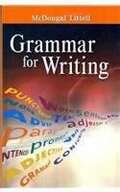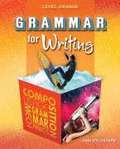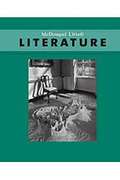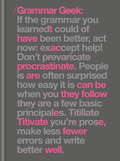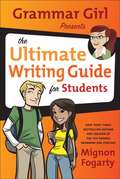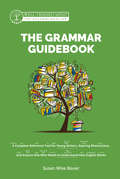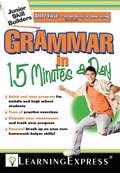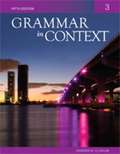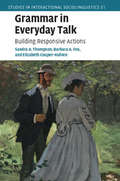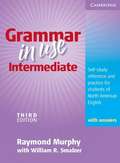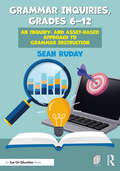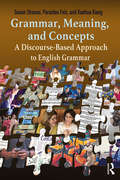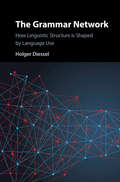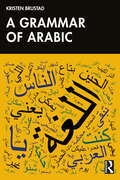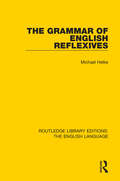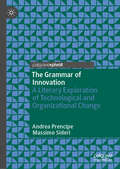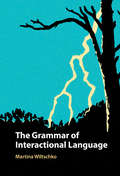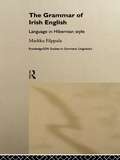- Table View
- List View
Grammar Geek
by Michael PowellEnglish is full of beauty and surprises, yet despite being the lingua franca of the globalization world, it has a reputation for being difficult to learn because its grammar has also so many quirks and contradictions. Did you know:- "Terry loves yogurt" is an example of illeism- preposition stranding is a bogus rule- sometimes it's acceptable to begin a sentence with "but" or "and"- "Could you pass the salt?" is "whimperative"- it's OK to boldly split infinitives Many of us don't even know the basics, so not only does Grammar Geek reveal obscure grammar rules and bogus ones you can safely ignore, it's also a handy primer, so in the future you'll have no excuse for dangling a modifier or misplacing a semicolon.
Grammar Girl Presents the Ultimate Writing Guide for Students
by Mignon FogartyNamed to the International Reading Association's 2012 Teachers' Choice book list, Grammar Girl Presents the Ultimate Writing Guide for Students is a complete and comprehensive guide to all things grammar from Grammar Girl, a. k. a. Mignon Fogarty, whose popular podcasts have been downloaded over twenty million times and whose first book, Grammar Girl's Quick and Dirty Tips for Better Writing, was a New York Times bestseller. For beginners to more advanced students, this guide covers it all: the parts of speech, sentences, and punctuation are all explained clearly and concisely with the warmth, wit, and accessibility Grammar Girl is known for. Pop quizzes are scattered throughout to reinforce the explanations, as well as Grammar Girl's trademark Quick and Dirty Tips--easy and fun memory tricks to help with those challenging rules. Complete with a writing style chapter and a guide to the different kinds of writing--everything from school papers to letter writing to e-mails--this guide is sure to become the one-stop, essential book on every student's desk.
The Grammar Guidebook: A Complete Reference Tool For Young Writers, Aspiring Rhetoricians, And Anyone Else Who Needs To Understand How English Works (Grammar for the Well-Trained Mind #0)
by Susan Wise BauerOn its own or as a supplement to the Grammar for the Well-Trained Mind program, this complete compendium of grammar rules and examples will become an indispensable guide to writing—throughout high school, into college, and beyond. With a new name, but the same, thorough, clearly-outlined rules of English Grammar, The Grammar Guidebook is the second edition to The Comprehensive Handbook of Rules. Originally designed to accompany the Grammar for the Well-Trained Mind program, this Grammar Guidebook stands on its own, assembling into one handy reference work all of the principles that govern the English language—from basic definitions (“A noun is the name of a person, place, thing, or idea”) through advanced sentence structure and analysis. Each rule is illustrated with examples drawn from great literature, along with classic and contemporary works of science, history, and mathematics. Grammar for the Well-Trained Mind is an innovative program that combines the three essential elements of language learning: understanding and memorizing rules (prescriptive teaching), repeated exposure to examples of how those rules are used (descriptive instruction), and practice using those rules in exercises and in writing (practical experience). Each year, parents and teachers go through the dialogue, rules, and examples in the Core Instructor Text; students follow along in the Student Workbook. This repetition solidifies the concepts, definitions, and examples in the student’s mind. There are four Student Workbooks, one for each year. Each Student Workbook contains the same rules and examples—but four completely different sets of exercises and assignments, allowing students to develop a wide-ranging knowledge of how the rules and examples are put to use in writing. Each Student Workbook comes with its own Key, providing not only answers, but also explanations for the parent/instructor, and guidance as to when the answers might be ambiguous (as, in English, they often are). All of the rules covered, along with the repeated examples for each, are assembled for ongoing reference in The Grammar Guidebook. Use Grammar for the Well-Trained Mind to teach English grammar thoroughly, effectively, and with confidence—no matter what your background or experience!
Grammar Handbook Grade 9
by Prentice-Hall StaffHelp your teenager gain confidence and skill in writing and speaking. Learning grammar rules gives children a boost in their ability to communicate effectively. Pearson@Home offers just what teens need to develop essential skills.
Grammar in 15 Minutes a Day
by Learningexpress StaffYou don't have to be an grammar genius to become a grammar pro-you can do it in just 15 minutes a day It's true: mastering grammar doesn't have to take a long time . . . and it doesn't have to be difficult In just one month, students can gain expertise in a wide variety of common middle-school grammar challenges that will set them on the course toward success for the rest of their lives. How? Each lesson of Junior Skill Builders: Grammar in 15 Minutes a Day gives one small part of the bigger grammar situation, so that each day, students build upon the previous day's knowledge. Fun factoids and catchy memory hooks help make sure that what students learn becomes ingrained. Before you know it, using grammar correctly becomes effortless-one step at a time. In just 15 minutes a day, students learn everything they need to know about: Nouns Pronouns Verbs Tenses Adjectives Adverbs Prepositions Conjunctions Interjections Subject and predicate Direct and indirect objects Phrases Clauses Compound and complex sentences Fragments and run-ons End marks Commas Semicolons Colons Quotation marks Underlining Hyphens Apostrophes Capitalization In addition to all the essential practice that kids need to ace classroom tests, pop quizzes, class participation, and standardized exams, Junior Skill Builders: Grammar in 15 Minutes a Day provides parents with an easy and accessible way to help their children excel. All it takes is just 15 minutes a day
Grammar in Context 3 (Fifth Edition)
by Sandra N. Elbaum Judi PemanHeinle's best selling grammar series now has more of what works for students and teachers! Students learn more, remember more, and use language more effectively when they learn grammar in context. Grammar in Context, Fifth Edition presents grammar in interesting, informative readings and then recycles the language and context throughout every activity.
Grammar in Everyday Talk: Building Responsive Actions (Studies in Interactional Sociolinguistics)
by Sandra A. Thompson Barbara A. Fox Elizabeth Couper-KuhlenDrawing on everyday telephone and video interactions, this book surveys how English speakers use grammar to formulate responses in ordinary conversation. The authors show that speakers build their responses in a variety of ways: the responses can be longer or shorter, repetitive or not, and can be uttered with different intonational 'melodies'. Focusing on four sequence types: responses to questions ('What time are we leaving?' - 'Seven'), responses to informings ('The May Company are sure having a big sale' - 'Are they?'), responses to assessments ('Track walking is so boring. Even with headphones' - 'It is'), and responses to requests ('Please don't tell Adeline' - 'Oh no I won't say anything'), they argue that an interactional approach holds the key to explaining why some types of utterances in English conversation seem to have something 'missing' and others seem overly wordy.
Grammar in Literature: A Text-based Guide for Students
by Susan Lavender Stavroula VarellaThis textbook familiarizes students with grammatical concepts of the English language and develops skills to apply grammar to creative writing and the study of literature. Students take an interactive 'learn-by-doing' approach to the mechanics of language and explore the creative uses of grammar. Experimenting with their own linguistic and creative skills, they come to appreciate the importance of language not only as a means of communication but also as an essential part of creative practice and literary composition. This applied approach to learning about grammar will be a valuable resource for students of English Literature and Creative Writing who may already be good users of grammar but not fully aware of its significance for communication and creativity.
Grammar In Use: Intermediate Student's Book With Answers
by Raymond Murphy William R. SmalzerIdeal for students preparing for the TOEFL r test or other standard examinations, the new edition of this popular North American English grammar title offers even more support, with a larger format to include more explanation and practice, eight new units on phrasal verbs, and 10 pages of Additional Exercises. The book is available with and without a CD-ROM, which includes additional practice exercises, progress reports, interactive games, and a link to the Cambridge Dictionaries Online. You can even create your own tests to review the language learned. The workbook provides students with further practice opportunities.
Grammar Inquiries, Grades 6–12: An Inquiry- and Asset-Based Approach to Grammar Instruction
by Sean RudayIn this book, grammar expert Sean Ruday shows you how to apply the principles of inquiry-based learning to improve your grammar instruction. Grammar often gets relegated to worksheets or rote tasks, but with this volume you’ll find a wealth of strategies and tools for making grammar instruction engaging and meaningful. Designed for middle- and high-school ELA teachers, this book covers all aspects of grammar instruction through an asset-based approach and includes many methods, ideas, and takeaways for instruction. Featuring real-world examples of student work and a sample lesson plan, this is an essential resource for teachers who wish to enliven instruction and teach grammar effectively.
Grammar Island
by Michael Clay Thompson Milton N KemnitzOn Grammar Island you learn that thinking about language is fun! Language is talking and writing. It is how we make our ideas out of words!
Grammar, Meaning, and Concepts: A Discourse-Based Approach to English Grammar
by Susan Strauss Parastou Feiz Xuehua XiangGrammar, Meaning, and Concepts: A Discourse-Based Approach to English Grammar is a book for language teachers and learners that focuses on the meanings of grammatical constructions within discourse, rather than on language as structure governed by rigid rules. This text emphasizes the ways in which users of language construct meaning, express viewpoints, and depict imageries using the conceptual, meaning-filled categories that underlie all of grammar. Written by a team of authors with years of experience teaching grammar to future teachers of English, this book puts grammar in the context of real language and illustrates grammar in use through an abundance of authentic data examples. Each chapter also provides a variety of activities that focus on grammar, genre, discourse, and meaning, which can be used as they are or can be adapted for classroom practice. The activities are also designed to raise awareness about discourse, grammar, and meaning in all facets of everyday life, and can be used as springboards for upper high school, undergraduate, and graduate level research projects and inquiry-based grammatical analysis. Grammar, Meaning, and Concepts is an ideal textbook for those in the areas of teacher education, discourse analysis, applied linguistics, second language teaching, ESL, EFL, and communications who are looking to teach and learn grammar from a dynamic perspective.
The Grammar Network: How Linguistic Structure Is Shaped by Language Use
by Holger DiesselCognitive linguists and psychologists have often argued that language is best understood as an association network; however while the network view of language has had a significant impact on the study of morphology and lexical semantics, it is only recently that researchers have taken an explicit network approach to the study of syntax. This innovative study presents a dynamic network model of grammar in which all aspects of linguistic structure, including core concepts of syntax (e.g. phrase structure, word classes, grammatical relations), are analyzed in terms of associative connections between different types of linguistic elements. These associations are shaped by domain-general learning processes that are operative in language use and sensitive to frequency of occurrence. Drawing on research from usage-based linguistics and cognitive psychology, the book provides an overview of frequency effects in grammar and analyzes these effects within the framework of a dynamic network model.
A Grammar of Arabic
by Kristen BrustadA Grammar of Arabic models a new framework for studying varieties of Arabic comparatively, highlighting the patterns of variation and consistency, and showing how different styles, from primarily spoken and casual to primarily written and formal, are linguistically interrelated.This non-traditional reference grammar is structured around patterns of usage rather than prescriptive rules, aligning function with form and taking advantage of general principles of language. Using data from Classical Arabic, Arabic, Modern Standard Arabic, and dialects spoken in Morocco, Egypt, Sudan, the Levant, Iraq, and the Arabian Gulf, this grammar examines the actual usage of these language varieties, broadening understanding of Arabic dialects from a linguistics perspective while also giving readers the ability to engage language diversity.Designed for instructors, researchers, and advanced students of Arabic, A Grammar of Arabic explores Arabic from an internally comparative perspective that will also be valuable to theoretical linguists.
The Grammar of Chinese Characters: Productive Knowledge of Formal Patterns in an Orthograhic System (Routledge Studies in East Asian Linguistics)
by James MyersAnybody who reads or writes Chinese characters knows that they obey a grammar of sorts: though numerous, they are built out of a much smaller set of constituents, often interpretable in meaning or pronunciation, that are themselves built out of an even smaller set of strokes. This book goes far beyond these basic facts to show that Chinese characters truly have a productive and psychologically real lexical grammar of the same sort seen in spoken and signed languages, with non-trivial analogs of morphology (the combination of potentially interpretable constituents), phonology (formal regularities without implications for interpretation), and phonetics (articulatory and perceptual constraints). Evidence comes from a wide variety of sources, from quantitative corpus analyses to experiments on character reading, writing, and learning. The grammatical approach helps capture how character constituents combine as they do, how strokes systematically vary in different environments, how character form evolved from ancient times to the modern simplified system, and how readers and writers are able to process or learn even entirely novel characters. This book not only provides tools for exploring the full richness of Chinese orthography, but also offers new ways of thinking about the most fundamental question in linguistic theory: what is grammar?
The Grammar of English Reflexives (Routledge Library Editions: The English Language #12)
by Michael HelkeThis work, first published in 1979, was a doctoral dissertation submitted to the Department of Foreign Literatures and Linguistics of the Massachusetts Institute of Technology in 1970. The first chapter of this thesis concerns the supposed complementarity of reflexives and ordinary anaphoric pronouns. In the second chapter a theory of reflexivisation is characterised which encompasses several other theories. The third chapter considers apparent counter-examples to the generalizations regarding reflexives that were established in Chapter Two. The fourth chapter concerns the meaning of reflexives. This book will be of interest of students of language and linguistics.
The Grammar of French Quantification
by Lena BaunazThis book is the first extensive study on French Quantification in the field of Syntax. It provides a typology of four main quantified noun phrases in French (existential, universal, negative and wh-), detailing their syntactic, semantic and prosodic behaviors and showing that they can be reduced to two classes--Split-DP structures or Floating quantification. Relying on syntax and semantics, the book establishes a three-way structural typology of wh in-situ phrases and extends it to existentials. It pays special attention to the prosodic properties associated with their different readings and proposes an analysis of the distribution of subextraction and pied-piping. Similarly based on semantic and syntactic tests, the book reveals N(egative) words to be universal Quantifiers. It proposes a new structure of N-words in terms of constituent negation and includes a detailed analysis of the difference between not an N and not all the N in French.
The Grammar of Hate: Morphosyntactic Features of Hateful, Aggressive, and Dehumanizing Discourse
by Natalia KnoblockHate speech continues to be an issue of key social significance, yet while its lexical and discursive aspects have been widely studied, its grammatical traits have been hitherto overlooked. This book seeks to address this gap by bringing together a global team of scholars to explore the morphosyntactic features of hateful and aggressive discourse. Drawing on thirteen diverse cross-linguistic case studies, it reveals how hate is expressed in political discourse, slang, and social media, and towards a range of target groups relating to gender, sexual orientation, and ethnic identity. Based on ideas from functional and cognitive linguistics, each thematic part demonstrates how features such as morphology, word formation, pronoun use, and syntactic structures are manipulated for the purpose of expressing hostility and hate. An innovative approach to an age-old problem, this book is essential reading for researchers and students of hate speech and verbal aggression.
The Grammar of Identity: Intensifiers and Reflexives in Germanic Languages (Routledge Studies in Germanic Linguistics)
by Volker GastEnglish self-forms and related words from other Germanic languages (e.g. Dutch zelf, Swedish själv, etc.) are used in two different functions: as ‘intensifiers’ (e.g. The president himself made the decision) and as markers of reflexivity (John criticized himself). On the basis of a comparative syntactic and semantic analysis, this book addresses the question of why two such apparently different functions can be expressed by the same word. This question is answered by showing that both intensifying and reflexive self-forms can be analysed as expressing the concept of ‘identity’. In the first part of The Grammar of Identity, the most central facts concerning the distribution of intensifiers in Germanic languages are surveyed and a detailed syntactic and semantic analysis is provided. It is shown that all instances of intensifiers can be analysed as expressions of an identity function. The second part of the book offers an analysis of reflexive self-forms which is based on recent theories of reflexivity, modifying these in some important respects. In particular, the distribution of reflexive self-forms is explained with reference to semantic properties of the sentential environment. In this way, it can be shown that reflexive self-forms – like intensifiers – can be analysed as expressions of an identity function. In addition to providing a thorough comparative description of the hitherto poorly described area of intensifiers in Germanic languages, this book offers an answer to a long standing question in descriptive and theoretical linguistics, namely why self-forms are used in two apparently different functions. By combining analytical methods from syntax, lexical semantics and sentence semantics the study moreover contributes to an understanding of the interaction between structure, meaning and context in a central area of lexico-grammar.
The Grammar of Innovation: A Literary Exploration of Technological and Organizational Change
by Andrea Prencipe Massimo SideriIn Six Memos for the Next Millennium, Italo Calvino elaborated on six concepts or memos to offer insights on the ‘shapes of things to come’, which were lightness, rapidity, exactness, visibility, multiplicity and consistency. To do so, the Italian writer embraced an interdisciplinary approach to describe each concept through juxtaposition of its antonyms, heaviness, slowness, indeterminacy, invisibility, uniqueness, and inconsistency. Inspired by Calvino’s intuition, this book puts forward the notion of the ‘Calvino Method’ to interpret the inner dynamics of innovation processes. Drawing on literature and cases from the fields of innovation, history of technology, organisation theory and corporate strategy, the book elaborates on each of the six concepts to offer a unique angle to understand innovation as technological, organisational and cultural change that generates value across a variety of domains. The linguistic juxtapositions at the root of the CalvinoMethod forms the framework of The Grammar of Innovation and the tension between opposites, which at first seems insoluble, emerges as the catalyst of future thought. This book will be of great interest to scholars of innovation, strategy, organisation studies, philosophy of business, and all those with an interest in the works of Italo Calvino.
The Grammar of Interactional Language
by Martina WiltschkoTraditional grammar and current theoretical approaches towards modelling grammatical knowledge ignore language in interaction: that is, words such as huh, eh, yup or yessssss. This groundbreaking book addresses this gap by providing the first in-depth overview of approaches towards interactional language across different frameworks and linguistic sub-disciplines. Based on the insights that emerge, a formal framework is developed to discover and compare language in interaction across different languages: the interactional spine hypothesis. Two case-studies are presented: confirmationals (such as eh and huh) and response markers (such as yes and no), both of which show evidence for systematic grammatical knowledge. Assuming that language in interaction is regulated by grammatical knowledge sheds new light on old questions concerning the relation between language and thought and the relation between language and communication. It is essential reading for anyone interested in the relation between language, cognition and social interaction.
The Grammar of Irish English: Language in Hibernian Style (Routledge Studies in Germanic Linguistics)
by Markku FilppulaIrish English, also termed 'Anglo-Irish' or 'Hiberno-English', as in this book, is not usually perceived as having a grammatical system of its own. Markku Filppula here challenges this misconception and offers a descriptive and contact-linguistic account of the grammar of Hiberno-English. Drawing on a wide range of authentic materials documenting Hiberno-English dialects past and present Filppula examines: * the most distinctive grammatical features of these dialects * relationships with earlier and other regional varieties of English * the continuing influence of the Irish language on Hiberno-English * similarities between Hiberno-English and other Celtic-influenced varieties of English spoken in Scotland and Wales The Grammar of Irish English is a comprehensive empirical study which will be an essential reference for scholars of Hiberno-English and of value to all those working in the field of Germanic linguistics.
